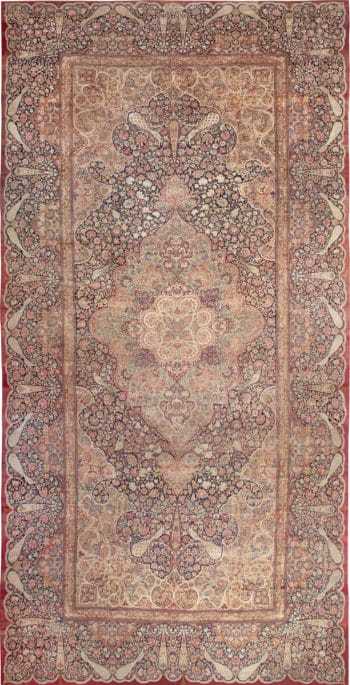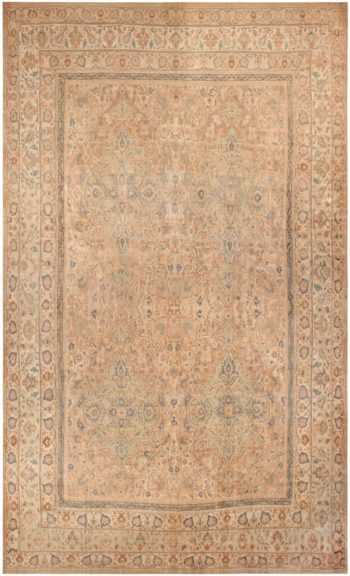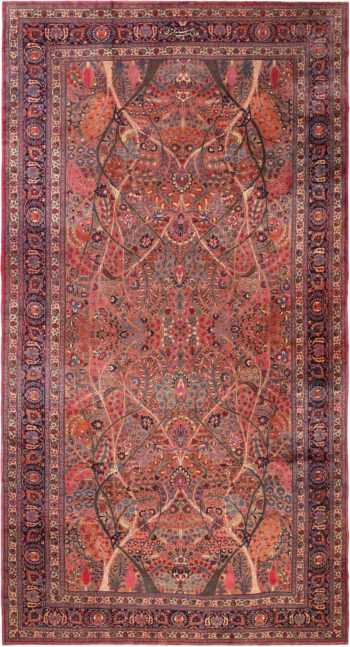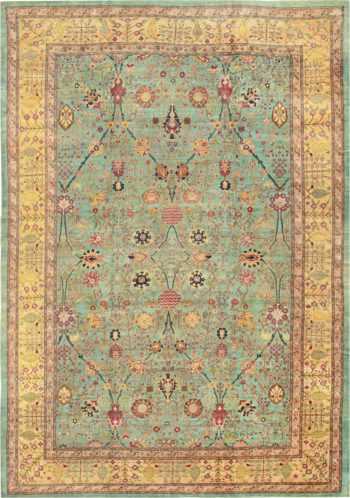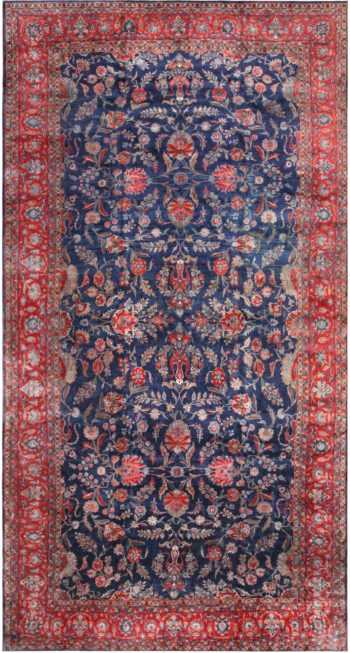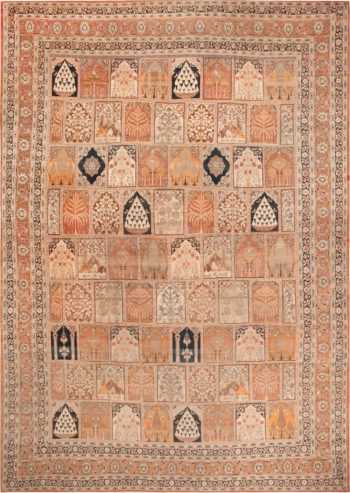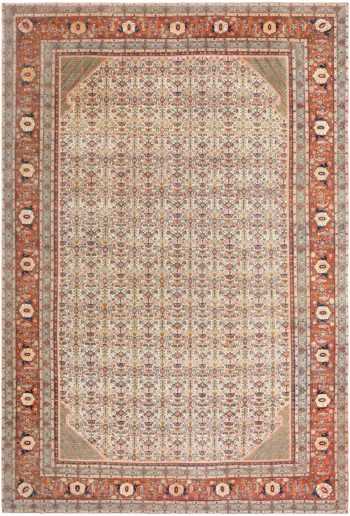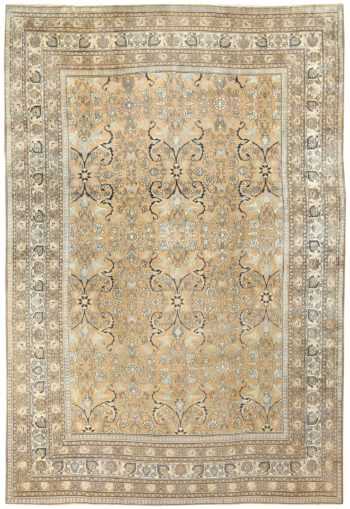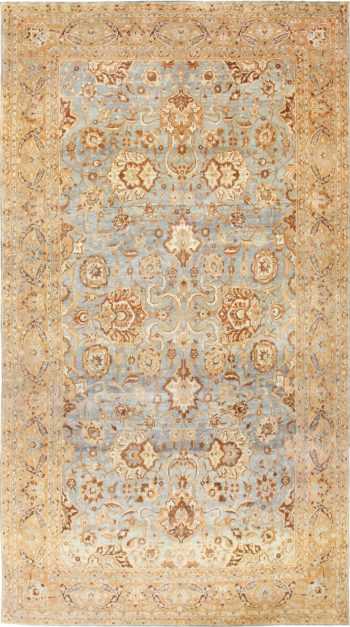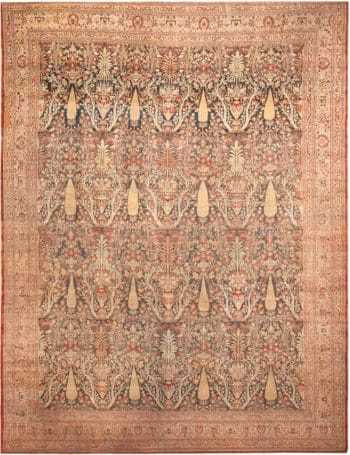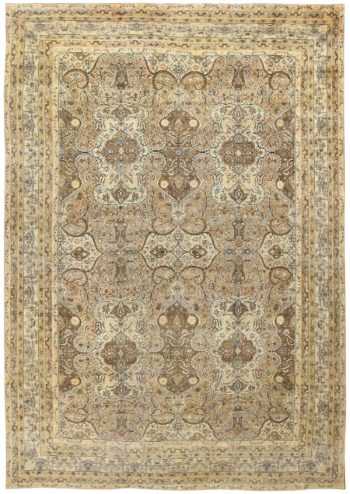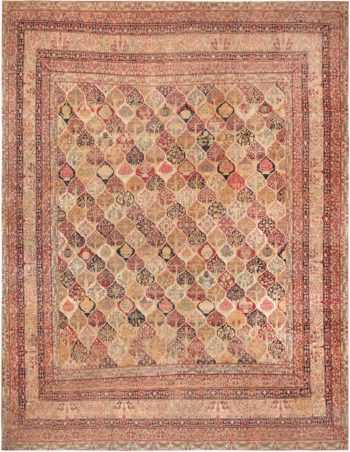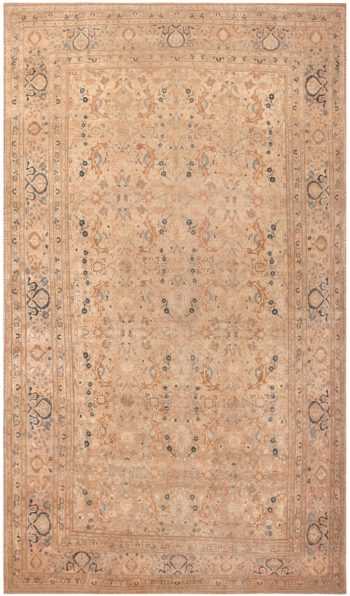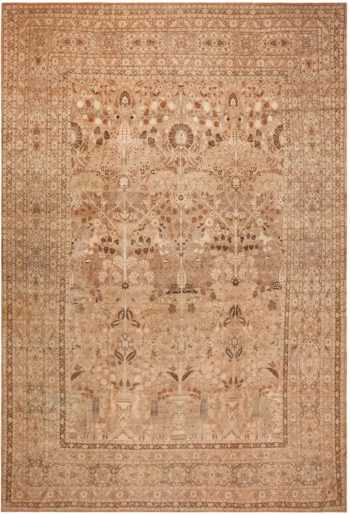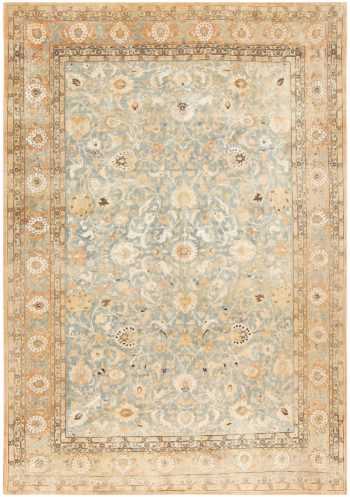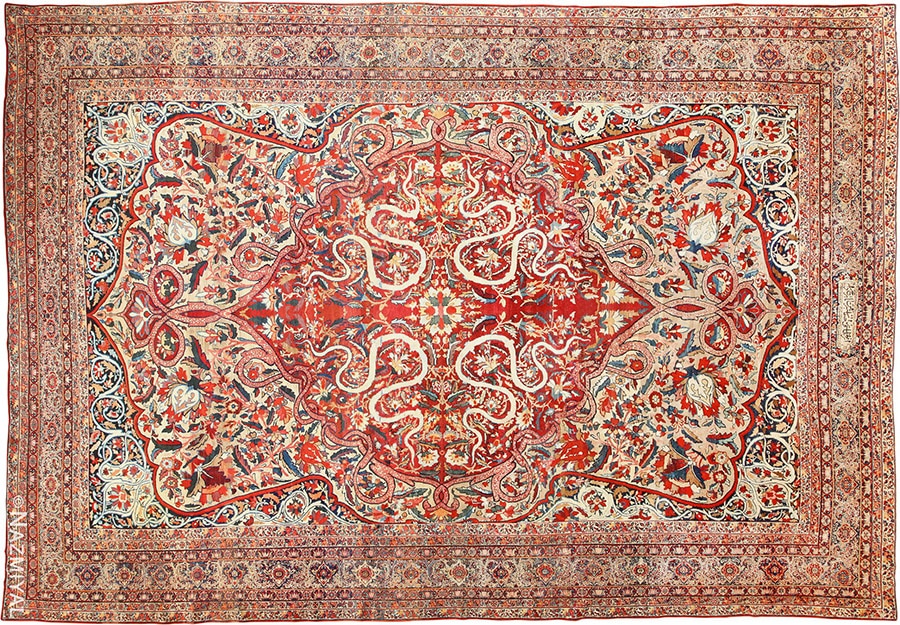Fine High Quality Rugs
View some of the most finely woven area rugs in the world for your inspiration:
Fine Oversized Floral Animal Design Antique Persian Kerman Rug 72499
$88,000.00Size: 14 ft 3 in x 29 ft 8 in (4.34 m x 9.04 m)Beautiful Oversized Fine Decorative Antique Casual Elegant Persian Khorassan Rug 71956
$148,000.00Size: 18 ft 1 in x 29 ft 1 in (5.51 m x 8.86 m)Fine Floral Tree Of Life Oversized Antique Persian Vase Design Khorassan Garden Rug 71842
$88,000.00Size: 12 ft 10 in x 24 ft 9 in (3.91 m x 7.54 m)Fine Floral Animal Design Antique Oversized Persian Tabriz Rug 72518
$89,000.00Size: 17 ft x 24 ft 7 in (5.18 m x 7.49 m)Large Oversized Seafoam Color Antique Indian Agra Rug 40317
Size: 15 ft 10 in x 23 ft (4.83 m x 7.01 m)Beautiful Fine Luxurious Oversized Antique Large Scale Allover Kerman Persian Rug 48690
$165,000.00Size: 14 ft 8 in x 21 ft (4.47 m x 6.4 m)Luxurious Fine Oversized Antique Persian Traditional Kashan Manchester Wool Rug 72080
$39,000.00Size: 11 ft x 20 ft 8 in (3.35 m x 6.3 m)Fine Beautiful Large Antique Persian Haji Jalili Tabriz Garden Design Rug 72070
$135,000.00Size: 14 ft 6 in x 20 ft (4.42 m x 6.1 m)Ivory Background Fine Large Size Antique Floral Persian Tehran Medallion Rug 71383
$64,500.00Size: 12 ft 6 in x 19 ft 6 in (3.81 m x 5.94 m)Finely Woven Large Size Beautiful Antique Ivory Haji Jalili Persian Tabriz Rug 48729
$46,000.00Size: 12 ft 10 in x 19 ft 2 in (3.91 m x 5.84 m)Fine Neutral Large Antique Decorative Allover Design Persian Khorassan Carpet 50072
$55,000.00Size: 13 ft 1 in x 19 ft 2 in (3.99 m x 5.84 m)Silk Large Antique Persian Tabriz Rug 71986
$96,000.00Size: 12 ft 2 in x 19 ft (3.71 m x 5.79 m)Antique Beautiful Fine Large Size Light Blue Persian Kerman Rug 48869
$96,000.00Size: 10 ft 6 in x 19 ft (3.2 m x 5.79 m)Fine Large Cypress Tree Vase Design Antique Persian Tabriz Rug 72427
Size: 13 ft 8 in x 18 ft 3 in (4.17 m x 5.56 m)Large Antique Persian Senneh Area Rug 71301
Size: 13 ft x 17 ft 8 in (3.96 m x 5.38 m)Bold Blue Fine Large Floral Antique Rustic Persian Sarouk Rug 71839
Size: 11 ft 4 in x 17 ft 4 in (3.45 m x 5.28 m)Large Soft Color Antique Persian Kerman Area Rug 50147
$34,000.00Size: 11 ft 8 in x 17 ft 3 in (3.56 m x 5.26 m)Beautiful Large Fine Garden Design Antique Luxurious Persian Kerman Rug 72038
$38,500.00Size: 13 ft 2 in x 17 ft (4.01 m x 5.18 m)Beautiful Large Decorative Ivory Cream Antique Fine Persian Tabriz Rug 71980
$42,500.00Size: 10 ft 2 in x 16 ft 9 in (3.1 m x 5.11 m)Beautiful Fine Neutral Decorative Large Antique Persian Tabriz Vase Tree Of Life Design Abrash Rug 71992
$39,000.00Size: 11 ft 7 in x 16 ft 8 in (3.53 m x 5.08 m)Large Antique Persian Kerman Garden Design Area Rug 3403
Size: 11 ft 11 in x 16 ft 1 in (3.63 m x 4.9 m)Rustic Fine Large Antique Persian Kashan Mohtashem Rug 72479
Size: 10 ft 4 in x 15 ft 8 in (3.15 m x 4.78 m)Fine Luxurious Silk and Wool Antique Persian Tehran Rug 48249
$36,000.00Size: 10 ft 6 in x 15 ft 6 in (3.2 m x 4.72 m)Beautiful Fine Floral Antique 19th Century Persian Kerman Hallway Runner Rug 44580
$16,000.00Size: 4 ft 8 in x 15 ft 4 in (1.42 m x 4.67 m)
Fine High Quality Rugs – What You Need To Know
All the Questions You May Have About Rugs and Carpets
Commercial Rugs Vs. Quality Rugs
Buying rugs is a big decision. Unlike coarse commercial grade carpets and rugs that you expect to replace at least once every five to ten years, hand-made carpets, especially the finer good quality rugs, are meant to last for at least several decades if not longer.
It is not uncommon to find antique rugs that have been around for over 100 years or more. By comparison, machine made area rugs, for the most part, are expected to have a maximum useful life of 10 years or less. When you purchase a hand knotted pile carpet, it is a commitment, so you want to make sure you are looking at high quality rugs.

Fine Good Quality Rugs
A fine hand carpet will last a lifetime if cared for properly. Not to mention, you can expect good quality rugs to be more expensive than mass-manufactured carpets as well. If you are considering adding a hand-knotted carpet to your home or office, it is important to understand what you are getting.
What Does It Mean When Someone Says “Fine” or “Good Quality” Rug?
Let’s talk a bit about what the term “fine rugs” means and how coarse and commercial carpets compare. When you begin your research into the type of rug that you wish to purchase, you will probably hear the word “fine” mentioned frequently. Even if you shop for commercial carpets, the salesperson will probably use the term “fine”. In the world of commercial carpets and the world of hand-knotted carpets, this term means something different.

Large Persian Fine Quality Rugs
In the commercial carpet world, the term “fine” typically refers to quality, texture or “beauty”. It is just a word that is used to make the carpet sound more appealing. When describing a hand-knotted carpet, the word means something different entirely. When someone talks about a fine hand-knotted carpet, they are talking about the rug’s knot count or knot density.
Knot density is the number of knots in a specified unit of measure. Many people assume that a carpet with a high knot count is automatically more valuable carpet. While this is a good general rule, it is not true in every case. Regional differences in weaving techniques and the materials available, as well as the design, affect the final knot count of the carpet. Let’s take a look at how these factors are treated in different types of hand-knotted carpets.
Knot Density and Quality Rugs
Knot density is found by counting the number of rug knots per square inch, square centimeter, or other unit depending on the country and preferred unit of measure. For this article, we will use knots per square inch, or KPSI. When talking about a fine weave versus a coarse weave carpet, the one with the higher knot count will be considered a finer weave, and the one with a lower knot count will be viewed as a coarse weave.
Although some general guidelines apply to all carpets in terms of whether a weave is fine or coarse, it is important to know whether the person is talking about carpets in general or carpets from a specific locality or region. Carpets produced in different areas of the world have typical knot counts for the rugs made in their location.
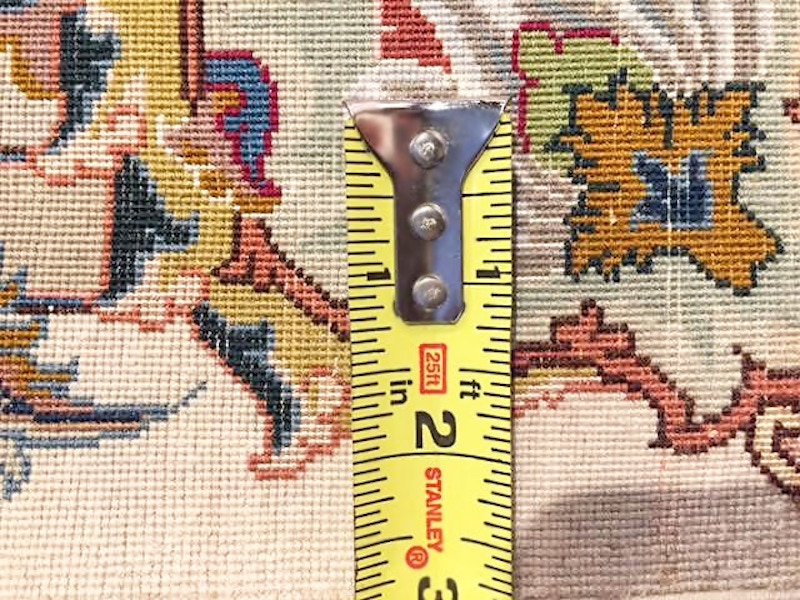
Finely Woven With High KPSI Rug
Also, many of the finer quality “city rugs” are produced in the weaving centers of the world, such as the Persian rug weaving cities of Tabriz and Kerman. These cities have been the home of formal carpet weaving schools since the 16th century.
Rug weavers in the carpet production city centers are trained to produce high quality rugs with a high knot count and delicate design. For instance, a carpet from Tabriz with a knot density of 400 kpsi would be considered average. It is not uncommon for carpets from this Persian city to reach knot counts into the 1000’s. By comparison, a tribal carpet may range between 50 and 80 kpsi. A tribal carpet with a kpsi of over 80 would be considered fine for that area, but coarse when talking about carpets in general – so it is all very relative.
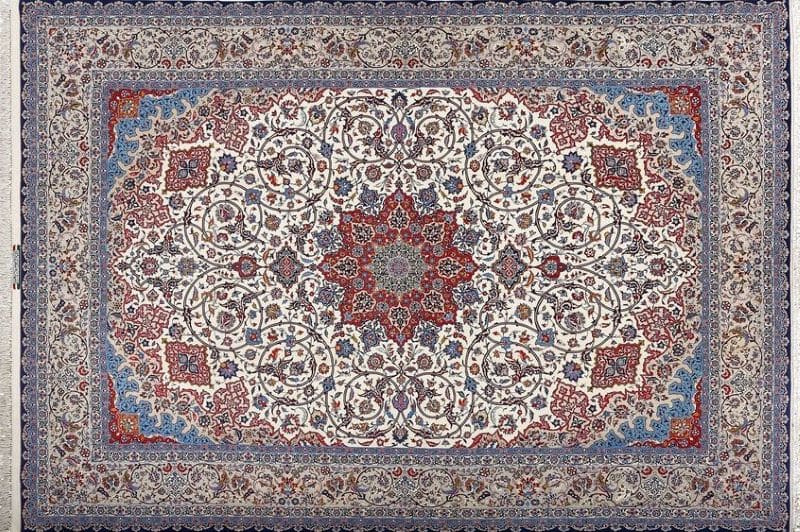
A Persian Isfahan rug with a fine quality weave. Fine weaves are often found in quality rugs.
When talking about knot count, you have to be clear whether it is referring to carpets in general or carpets from a specific area. Comparing carpets woven in the weaving centers of the cities to those rugs created in villages is like comparing apples and oranges. They are two different worlds and must be judged against carpets that are similar to them.
Knot count does have to do with quality, but not in the way many think that it does. If one were to take two carpets produced in the same area with a similar design, and all other qualities being the same, the one with the higher knot count would be considered to be the better carpet. A knot count of 200 kpsi in one area may be an example of fine quality weaving, but in a different area of the world, it would not even be acceptable as a beginners weaving student’s work.
The bottom line is this…. When talking about knot count and whether a carpet is coarse or fine, this conversation has to take into account the context and average knot count of carpets from that local area.
Designs Of Good Quality Rugs vs Coarse Weave Carpets
In general, knot count ranges in rugs from about 25 to over 1,000 kpsi. Anything below 80 kpsi is considered to be coarse and of “low quality”. Knot counts between 80 and 120 are mostly considered okay quality / acceptable. Those with a knot count of 120- 330 kpsi are considered medium to good, and those above 330 kpsi are generally considered to be fine and good quality rugs. However, knot count is not the only determining factor of the quality of a carpet; it is only one of many.

This high quality Persian rug from Nain was hand woven with silk highlights and has a high knot count.
Carpets with a higher knot count can include a more intricate design. A higher knot count is more suitable for delicate curves and shading. The coarse tribal rugs often use larger scale geometric shapes with straight lines. They seldom use round and curvy lines because the knot density is too low to allow for this. This gives the carpet a more rustic and tribal look.
How Long Does It Take To Weave A Better Quality Rug?
Finer woven quality carpets take longer to weave. A carpet that measures 9-foot by 12-foot and has a knot count of 500 kpsi takes over 12 months to complete. This is with four or five rug weavers working 8 hours a day and six days a week. The average weaver can tie between 4,000 and 8,000 knots in a day.
How much does a good quality rug cost?
As noted above, fine / good quality rugs take longer to weave so a modern rug that is fine will cost more than a similar size modern rug with a courser weave.
In addition to the rug’s weave quality / density of knots per square inch , the actual price of rugs will be based on things like:
- Rug size – The bigger the rug the longer it took to make plus you would need to source more rug weaving materials. Plus the shipping will increase in cost as the rug weighs more.
- Materials used to weave the rug – some materials will cost more. For example, sourcing wool or even banana silk of the rugs would cost a fraction of what sourcing real silk will cost.
- Design – Some designs are more intricate and will require more time to render. The longer it takes to make, the more a rug will cost.
- Rug origin / the actual location where the rug was woven – Labor costs vary in different places world. For example, Tibetan rugs will cost more than (the same basic) rugs made in India.
Please note that the above is mostly true with regards to modern rugs. Antique rugs are priced differently and rarely do things like quality and size affect the price in a significant way like they would for a brand new area rug.
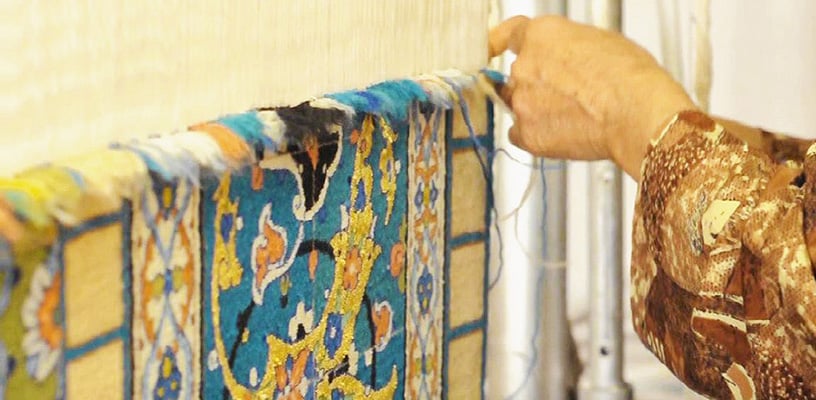
Weaving A Good Quality Persian Rug
What Was The Finest Rug Ever Woven?
Just for the record, it is believed that the highest knot count / finest rug ever woven was a small 12-inch by 24-inch silk rug from China. It has a knot count of close to 5,000 kpsi. Among larger carpets, there are several that claim to have the highest not counts in the world. Currently, it is thought that a Hereke , which also happens to be a prayer rug, housed in the Metropolitan Museum of Art holds the record with a knot count of 4,360 kpsi. The carpet took over 14 years to produce.
How Do Commercial Carpets Measure Up?
Now that you understand a little bit about how quality rugs and handmade carpets compare to each other, let’s take a look at some commercial carpets. By commercial carpets, we are referring to those that are made entirely by high speed machines. Commercial carpets are measured using the “face weight”, also known as the “pile weight”. This measurement reflects the ounces of yarn is used to make a square yard of carpet. Typical commercially made carpets range between 16 and 40 oz per yard.

Coarse Carpet Weave Vs Finely Woven Rug
Commercial carpets usually have a short pile and high-density. This allows them to last longer under heavy foot traffic. They are often made of synthetic fibers such as viscose, nylon, acrylic, polyester and olefin. There is stiff competition to increase quality and there are some carpets that are now available which have up to 100 ounces per square yard. In general, the higher the face weight, the longer the carpet will last.
When it comes to choosing between a good quality rugs that are handmade and commercial coarse carpets, the choice is clear. While the hand-knotted carpets are more expensive because of the labor involved, the commercial grade carpets will never match their appeal. Even though it is possible to achieve incredibly high densities with commercial carpets, they will never be as soft as a hand-knotted Persian area carpet in a fine weave. Regardless of how dense the commercial carpet is, it will always have a bit of a “scratchy” feel underfoot. Wool or silk feels soft and plush in a way that commercial carpets can never achieve.

Hand knotting a fine quality rug
Now you understand a little bit about knot density and how it plays a role in the quality of the rug. In general, when talking about hand-knotted carpets, the higher the knot density, the more intricate the pattern and the longer the carpet can be expected to last. With commercial carpets, the same is true, but when it comes to the feel under feet, commercial carpets can never compete with a nicely made hand-knotted quality rug.
What Makes A High Quality Fine Rug So Special?
What is a quality area rug?
A quality area rug is a rug that was woven with more knots per square inch than most other area rugs.
In the world of carpets and rugs, those with a fine weave are a pleasure to behold. Finer rug weaves allow for the creation of awe inspiring detail. Fine rugs have a suppleness that coarse weaves lack. They also allow for the threads to be packed tightly, which creates more durable carpets. Fine rugs are a real treasure to find, as they require considerably more time and skill from the rug weaver. They set themselves apart and have much more to offer than their high kpsi (knots per square inch) counterparts.

Fine Rugs
How can you tell if a rug is good quality?
A fine weave / good quality rug is one that has a high knot count. The density of the knots is what determines whether a rug is considered to be coarse or fine. The simplest definition of knot density is determined by counting the number of knots in a square inch of weaving. It is possible that the knot counts can be different in the horizontal and vertical direction. The knot density typically can range from anywhere from 25 to over 1,000 knots per square inch (KPSI). Sometimes this measurement is translated into centimeters (knots per square centimeter – KPSC), or another measurement according to country or region. For instance, the knots per “dihari” is used in India.
To find the overall knot count, you simply multiply the number of knots in a vertical inch of weaving with the number of knots in a horizontal inch of weaving. The number of knots in a certain area is simply a way of describing the fineness of the rug and serves as a point of comparison. It is considered a measure of quality and has an effect on the value of a rug, but it is not the only determining factor. It may be noted that certain ranges of kpsi are associated with various regions of rug production. Many times, the materials available are a determining factor as to the quality of rugs that can be produced.

Fine Silk Pile Turkish Hereke Rug
A fine rug takes much longer to produce than a rug of lower knot density. The most skilled weavers can only tie about 10,000 knots per day. This means that at the end of the day, they have finished a smaller section of a fine rug, as opposed to a coarser one. It can take several years to complete a fine rug, as opposed to several months to complete a coarse one. This affects the price / value of the rug, as fine rugs require more effort, time, and materials to produce.
What Affects the Fineness of the Rug?
There are several factors that serve to limit how fine a weave can be produced. One of them is the type of material that is available. Silk is prized for its ability to be spun into threads as fine as a spider web but still retain their strength. Silk allows for the finest rugs to be woven, particularly those that use both a silk pile and foundation.
The material that is second in terms of its ability to be spun finely is cotton. Wool and other exotic fibers such as yak or camel hair are known for producing coarse threads. With wool, there is a high degree of variability in the coarseness of the hand spun yarn that can be produced. Some sheep breeds, such as merino, can produce extremely fine threads, but they will never be as fine as silk. Many of the more primitive breeds of sheep, such as those reared by nomadic tribes, can only produce a coarse, rough textured yarn.
To weave a fine rug, you first have to start with a finely spun material. The next consideration is the type of knot. The Ghiordes rug knot, or symmetrical knot, is considered to produce a much more durable weave. However, it cannot produce as fine of design as the Senneh, or asymmetrical knot that we see in many of the fine Persian rugs. Many fine rugs use the Senneh knot to achieve cleaner lines in the rug design and a finer knot density. The use of the Senneh knot can be compensated for in terms of strength by the strength of the materials used and by packing the threads tightly.
The final factor that determines the knot density of the rug is the skill of the weaver. The master rug weavers who create these masterpieces are often trained from the time they are young children. They gain skill and the ability to produce higher quality carpets as they grow older. They develop the skills to produce more detailed designs and to pack the knots more tightly to produce a more durable rug.
Why Are The Fine Quality Rugs With High KPSI So Special?
Aside from the density of knots, there are many reasons why fine or high knot density rugs are special. If one were to compare two different rugs of the same design, age, and condition, the kpsi would be the determining factor in which one was the more valuable of the two. However, it is possible for a carpet of lower knot density to be more valuable than one of higher density, depending on other factors such as age, condition, design, and the region where it was produced.

Knots Per Square Inch Rug KPSI
In addition, fine rugs allow for more intricate designs and are suitable for elaborate motifs carried out in breathtaking detail. Higher knot count allows curved lines to appear round, instead of jagged. This allows for greater development of the fine details and expanded design potential. Coarse rugs are suitable for angular geometric designs, but to produce the realistic pictorial rugs or detailed floral designs, a higher knot count is necessary. When you look at rug, it is easy to make a reasonable guess as to knot count by looking at the level of detail in the design.
Finer weave rugs will also tend to have a shorter pile length, which allows them to be soft and supple without losing strength. Fine rugs must be sheared shorter to avoid appearing blurry and losing the details due to the wool spreading out towards the end. Closely woven carpets with a low pile create a visual effect that reflects the light differently from longer pile carpets. They have a captivating look that lets you know the care and labor that went into them.
When you see a fine carpet, you know it, even before you know the knot count. The colors are brighter, the edges are sharper and the pattern is crisper. They have a luminous glow that is not seen in coarser carpets. They give the room a feeling of warmth and vibrancy.
Feel free to browse our spectacular collection of high knot density carpets and you will be sure to find the perfect one that will give your space the touch of elegance that it deserves.
When shopping high knot count fine quality area rugs:
We at Nazmiyal Rugs have a large selection of hand-knotted carpets in our collection in a range of knot densities. However, we encourage you to look beyond the knot density when it comes to evaluating the carpet that is right for you. The most important factor is that you fall in love with it because you will have to live with it for many years to come, in the most likely circumstance. Finding the perfect rug for your space and that appeals to you is always the best criteria for choosing the right carpet for you.

